Martin Owens over at DoctorMo’s blog designed an impressive set of visuals detailing a wide range of computer ports. Any self-respecting geek should know these, they do come in handy from time to time:

-
Serial Port: A serial communication physical interface through which information transfers in or out one bit at a time
-
[PS/2 Connector]:(http://en.wikipedia.org/wiki/PS/2_connector) Is used for connecting some keyboards and mice to a PC compatible computer system. Its name comes from the IBM Personal System/2 series of personal computer
-
Parallel Port: Sends several data signals simultaneously over several parallel channels (as opposed to the Serial Port)
-
Games Port: The traditional connector for video game input devices on x86-based PCs
-
All these ports have been replaced by USB
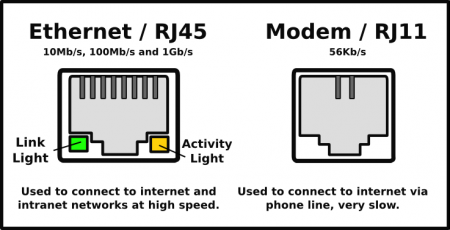
-
Ethernet/RJ45: Martin’s illustration calls this RJ45, however according to Wikipedia, this is incorrect and should be called 8P8C (8 Position 8 Contact.) They are used typically used to terminate twisted pair
-
Modem/RJ11: a physical interface often used for terminating telephone wires
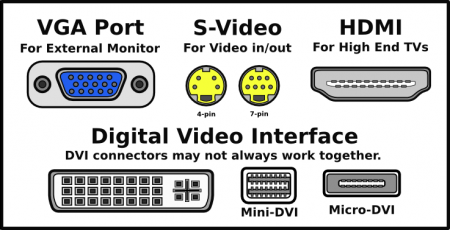 ]
]
-
VGA Port: Acronym for Video Graphic Array. Use this for external monitors
-
S-Video: Separate video (not Super Video) carries the video data as two separate signals, lumen (luminance) and chroma (color)
-
HDMI: High Definition Multimedia Interface is a compact audio/video interface for transmitting uncompressed digital data
-
DVI: Digital Video Interface is a video interface standard designed to provide very high visual quality on digital display devices such as flat panel LCD computer displays and digital projectors
-
Mini-DVI: This connector is used on Apple computers as a digital alternative to the Mini-VGA connector
-
Micro-DVI: This port is a video connection port used by some Apple MacBook Air laptop computers produced between January-October 2008

-
Audio Mini-Jacks Sockets are self-explainable, you can find more comprehensive description of this interface here
-
S/PDIF: Or SonyPhillips Digital Interconnect Format
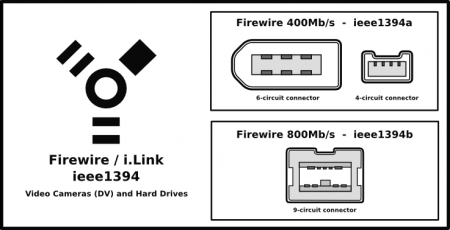
-
Firewire 400MB/s: Can transfer data between devices at 100, 200, or 400 Mbit/s half-duplex data rates
-
Firewire 800Mb/s: Can transfer data at a rate of 786.432 Mbit/s full-duplex
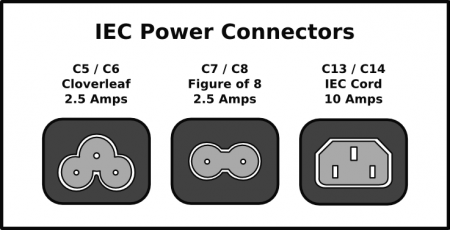
-
C5 / C6: “Cloverleaf” or “Mickey Mouse” power connectors can be seen on the majority of laptop power supplies and portable projectors
-
C7 / C8: C7 is also sometimes called “Shotgun.” These connectors can be found on cassette recorders, battery/mains operated radios, some full size AV equipment, laptop computer power supplies, video game consoles
-
C13/C14: C14 is used as an inlet to attach the power cord to the power supply, as do many monitors, printers and other peripherals. While many older computers also provide a panel-mounting C13 outlet for powering the monitor
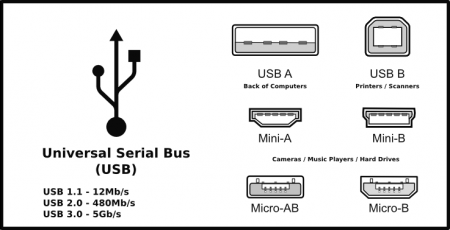
-
USB-A: This kind of plug is most frequently seen on cables that are permanently attached to a device, such as one on a cable that connects a keyboard or mouse to the computer
-
USB-B: Typically plugs into an upstream receptacle on a device that uses a removable cable, e.g. a printer
-
Mini-A & Mini-B: Mini-A is now deprecated, but both these plugs are plugs are approximately 3 by 7 mm. These are used in PDA’s, mobile phone, and cameras
-
Micro-B: Micro plugs have a similar width as the Mini’s but approximately half the thickness. These enable integration into thinner portable devices.
-
Micro-AB: This receptacle is capable of accepting either a Micro-A plug or a Micro-B plug
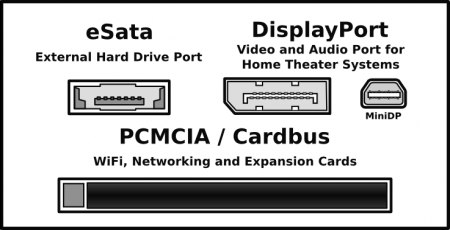
-
eSata: External Serial** Advanced **Technology Attachment, standardized in 2004, provides a variant of SATA meant for external connectivity
-
DisplayPort: Is a digital display interface standard put forth by the Video Electronics Standards Association (VESA) since 2006
-
MiniDP: A miniaturized version of the DisplayPort used by Apple
-
PCMCIA: Personal Computer Memory Card International Association is used in a wide range of products such as WiFi, networking and memory
Images are Copyright 2009, Martin Owens, Creative Commons BY-SA